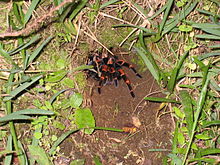Megaphobema mesomelas
| Megaphobema mesomelas | ||||||||||||
|---|---|---|---|---|---|---|---|---|---|---|---|---|

Megaphobema mesomelas |
||||||||||||
| Systematics | ||||||||||||
|
||||||||||||
| Scientific name | ||||||||||||
| Megaphobema mesomelas | ||||||||||||
| ( OP-Cambridge , 1892) |
Megaphobema mesomelas (rarely also red- legged tarantula ) was previouslyassigned tothe genus Brachypelma . Its distribution area is Costa Rica . Their natural environment is the highlands. There is more frequent precipitation and there is a constant high wind, as well as average temperatures around 15 to 20 degrees Celsius. It often nests in self-dug caves. The authors describe their behavior contradictingly: from very calm and never aggressive to slightly aggressive. Keeping it in a terrarium is possible, but very difficult due to special climatic requirements.
features
Megaphobema mesomelas reaches a body length (bite claws to spinnerets) of six centimeters. It has a velvety black basic color. In contrast, the spider looks brown before shedding its skin. The patellae of the legs are orange to russet in color. In some specimens, the tibia and metatarsi of the first two pairs of legs are partially or sometimes completely orange. The bite claws as well as the coxa and trochanter of the legs are lighter in color than the femur. Like the carapace and the opisthosoma, the femur is dark brown to deep black. The carapace is oval and elongated. The opisthosoma looks velvety black and has longer red-brown hair, especially at the back. In addition, there are stinging hairs on the back of the opisthosoma. This species of tarantula is one of the so-called "bombardier spiders". The males are colored the same as the females. Their habitus, on the other hand, is smaller and more delicate, as is the case with most species of tarantulas.
habitat
The animals occur at higher altitudes (1500 to 2700 meters above sea level). The habitat is often foggy and very humid due to frequent precipitation (90% relative humidity). The temperatures are in a low range compared to other tarantula habitats. During the day the thermometer reaches 14–20 ° C and at night it drops to 10–15 ° C. Adult animals dig their up to one meter long living tubes in embankments. Most of the tubes are not that long, they only reach 20 to 30 centimeters into the earth's interior. They are created at a height of one to 1.5 meters in the embankment opposite the horizontal ground. Few insects but a few centipedes were discovered in their habitat in autumn , which served as food for tarantulas.
behavior
The spider rarely shows aggressive behavior towards disturbances from supposed attackers. It rarely defends itself against an opponent with its biting claws, but in most cases only lifts the first pair of legs first. Only after repeated disturbances does it bite. The males, on the other hand, are more defensive and defend themselves more quickly. Although the spiders have stinging hairs on the opisthosoma, they are seldom stripped off in defense.
Mating in captivity (terrarium keeping) is peaceful and only lasts for a short time (a few minutes). Mating also takes place with older and therefore weaker males. The males are not eaten by the females. After three to six months after successful mating, the female builds a cocoon that contains around 100–150 eggs.
Web links
Megaphobema mesomelas in the World Spider Catalog
literature
- Klaas, Peter (2003): Tarantulas: Origin, Care, Species . Eugen Ulmer Verlag, Stuttgart. ISBN 3-8001-3696-1
- Schmidt, Dr. Günther (1993): tarantulas, way of life - identification key - husbandry - breeding . Landbuch Verlag, Hanover. Pp. 77-82. ISBN 3-7842-0484-8
- Tinter, Andreas (2001): Tarantulas . Nikol Verlagsgesellschaft mbH & Co. KG, Hamburg. ISBN 3-933203-49-X
